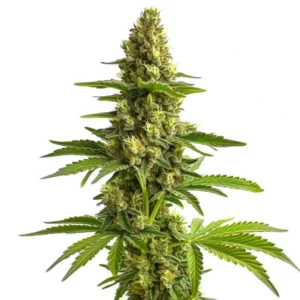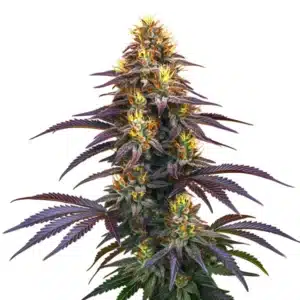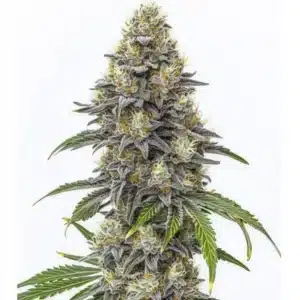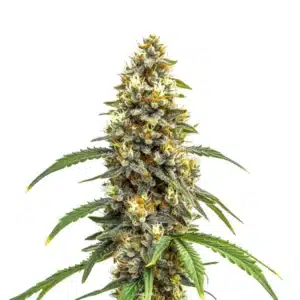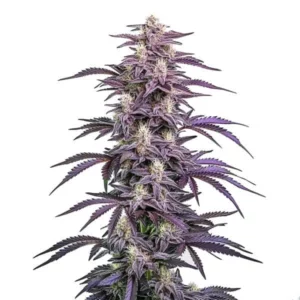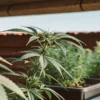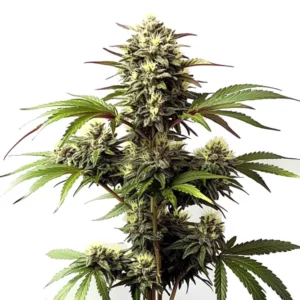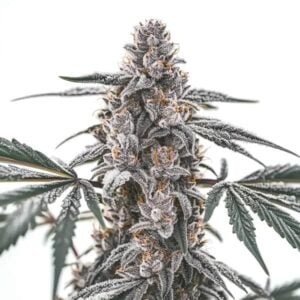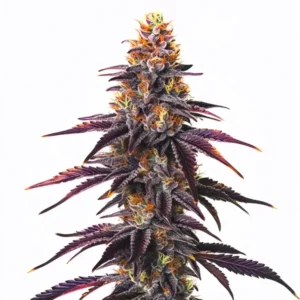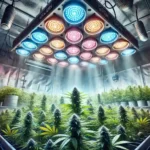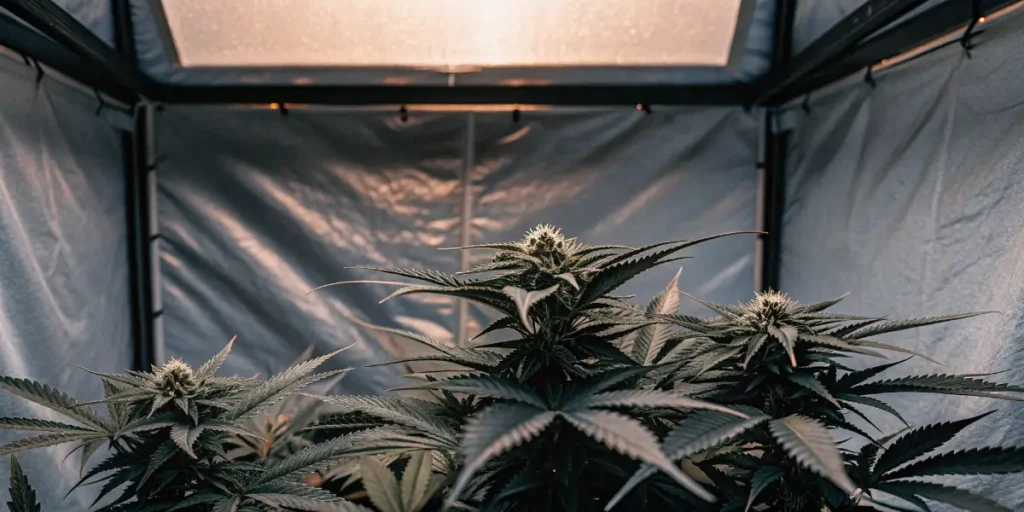
Best Light Spectrum for Growing Cannabis Indoors
Growing cannabis indoors requires careful attention to many factors, but none is more critical than the light spectrum. The best light spectrum for growing cannabis indoors can significantly impact your plant’s health and yield. Light spectrum refers to the range of light wavelengths that plants use for photosynthesis. Each wavelength has its role, and balancing them is key to successful growth.
When choosing the optimal light spectrum for indoor cannabis growth, it’s essential to mimic natural sunlight as closely as possible. Cannabis plants thrive under a full spectrum of light, which includes all wavelengths from ultraviolet (UV) to infrared (IR). This full spectrum lighting for indoor cannabis ensures that plants receive the energy they need at every stage of growth.
Recommended Strains
Bruce Banner #3
|
|
THC | 20% - 29% (High) |
|
|
Type | Feminized |
|
|
Yield | Medium |
|
|
Phenotype | 50% Indica / 50% Sativa |
Black Domina
|
|
THC | 15% - 20% (Medium) |
|
|
Type | Feminized |
|
|
Yield | High |
|
|
Phenotype | 95% Indica / 5% Sativa |
Let’s not forget that different phases of a cannabis plant’s life require different light spectrums. During the vegetative stage, plants benefit from blue light, while red light is more suitable during flowering. This means that finding the most effective light spectrum for indoor weed growth involves adjusting the balance of blue and red light according to the plant’s needs.
The Science Behind Light Spectrums and Cannabis Growth
The science of light spectrums can seem complicated, but breaking it down makes it easier. Light is made up of different wavelengths, which our eyes perceive as colors. Plants, including cannabis, use these wavelengths in photosynthesis, the process by which they convert light energy into chemical energy. The light spectrum’s effect on cannabis is profound, influencing growth rates, leaf development, and flowering.
Blue light, which is found at the lower end of the visible spectrum, promotes vegetative growth. It encourages thick leaves and strong stems, making it ideal for the early stages. On the other hand, red light, situated at the opposite end of the spectrum, facilitates flowering and budding. Combining these can create the ideal light wavelengths for growing marijuana indoors.
Knowing the interaction between light spectrums and plant physiology can aid in selecting the best light spectrum for growing cannabis indoors. The careful balance of blue and red light not only supports photosynthesis but also regulates plant hormones that play a pivotal role in growth dynamics. This makes the knowledge of light spectrums a powerful tool in cannabis cultivation.
Moreover, recent advancements in lighting technology have enabled growers to fine-tune the light spectrum to meet specific plant needs. This precision allows for the optimization of growth conditions, ensuring the plants receive the best possible care. By adjusting the spectrum according to the growth phase, growers can achieve higher yields and healthier plants.
Choosing the Best LED Spectrum for Cannabis Cultivation
LED lights have become a popular choice for indoor cannabis growers. They offer a customizable spectrum, energy efficiency, and a long lifespan. When selecting the best LED spectrum for cannabis cultivation, look for lights that offer both blue and red wavelengths. This ensures your plants receive the necessary light at each growth stage.
Many LED lights come with adjustable spectrums, allowing you to switch between vegetative and flowering modes. This flexibility is crucial for optimizing growth. Consider using full-spectrum LEDs, which provide a balance of blue, red, and other wavelengths, closely mimicking natural sunlight.
Additionally, LED technology continues to evolve, offering more precise control over the light spectrum. This advancement allows growers to experiment with different spectral combinations to find the most effective light spectrum for indoor weed growth. By tailoring the light to specific strains and growth stages, growers can significantly enhance plant performance.
LED lights also contribute to a more sustainable growing environment. Their energy efficiency reduces electricity consumption, while their longevity decreases waste. These features, combined with their effectiveness in providing the optimal light spectrum for indoor cannabis growth, make LED lights an environmentally friendly choice for any indoor garden.
Promos & Deals
Practical Tips for Using Full Spectrum Lighting
Using full spectrum lighting for indoor cannabis cultivation offers many advantages. It provides plants with a balanced range of wavelengths, supporting all growth stages. Full spectrum lighting is particularly beneficial for first-time growers, as it reduces the need to switch lights between growth phases.
When setting up your grow space, position your lights at an appropriate distance from your plants. Too close, and you risk burning; too far, and your plants may become leggy as they stretch toward the light. A good rule of thumb is to start with the lights about 18-24 inches above the canopy and adjust as needed.
Another practical tip is to monitor your plants closely and adjust lighting conditions based on their response. Factors such as leaf color, growth rate, and canopy density can provide insights into whether your plants are receiving the ideal light wavelengths for growing marijuana indoors. Regular observation and adjustments can help prevent issues and promote vigorous growth.
Furthermore, integrating timers and light intensity controllers can streamline the cultivation process. These tools enable precise control over lighting duration and intensity, ensuring plants receive consistent and optimal light exposure. By strategically managing your lighting setup, you can boost plant health and maximize your indoor cannabis yield.
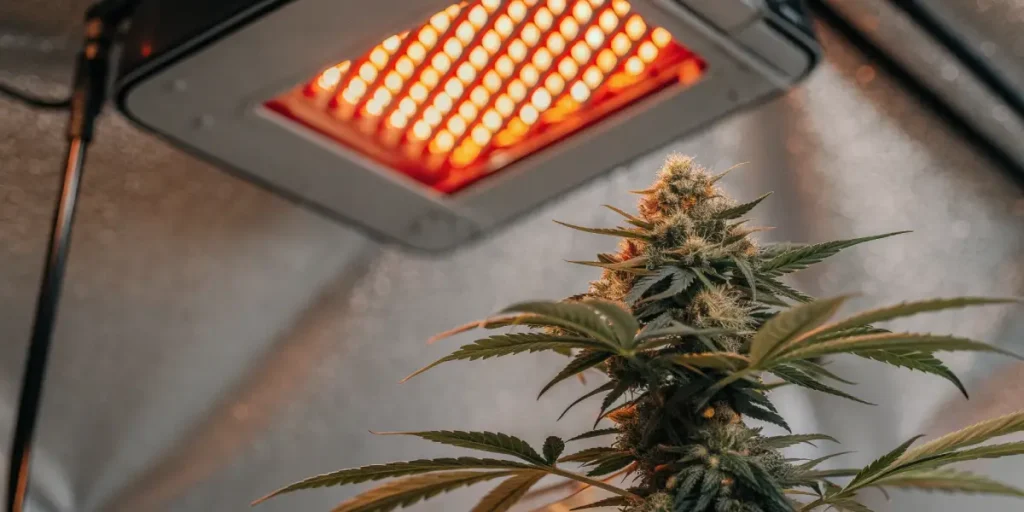
Maximizing Yield with the Right Light Spectrum
Maximizing yield is the ultimate goal for many cannabis growers. The most effective light spectrum for indoor weed growth doesn’t just enhance plant health; it also boosts yield. By tailoring the light spectrum to each growth stage, you can encourage your plants to produce more buds.
Begin by ensuring your plants receive ample blue light during the vegetative stage. This promotes robust growth and prepares the plant for the flowering phase. As you transition to flowering, increase the red light to stimulate bud development. This balance is crucial in maximizing the harvest.
Besides to spectrum adjustments, consider other factors that can influence yield, such as the strain genetics and environmental conditions. Strains like Bruce Banner 3 and Black Domina from Blimburn Seeds are known for their high yields, and providing them with the optimal light spectrum for indoor cannabis growth can further enhance their productivity.
Consistency and patience are key when aiming to maximize yield. Regularly assess your growing environment, and make incremental changes to your lighting strategy as needed. This iterative approach, combined with a focus on the best light spectrum for growing cannabis indoors, will help you achieve impressive results and a bountiful harvest.
FAQs on Light Spectrum and Indoor Cannabis Growth
What is the best light spectrum for growing cannabis indoors?
The best light spectrum for growing cannabis indoors is a full spectrum that includes blue, red, and other wavelengths. This combination mimics natural sunlight, providing plants with the energy needed for photosynthesis at all growth stages. Full spectrum lighting is particularly beneficial as it eliminates the need to change lights or adjust settings frequently.
Using full spectrum LEDs that offer adjustable settings for vegetative and flowering phases can help tailor the light to your plants’ needs. This approach ensures that cannabis plants receive the ideal light wavelengths for growing marijuana indoors, leading to healthier plants and better yields.
For those new to indoor cannabis cultivation, starting with full spectrum lighting simplifies the growing process. It offers a comprehensive solution that supports plant health and growth without the complexities of managing multiple light sources. This ease of use makes full spectrum lighting an attractive option for beginners and experienced growers alike.
Ultimately, the best light spectrum for growing cannabis indoors is one that aligns with your specific cultivation goals. Whether you prioritize yield, potency, or plant health, tailoring the light spectrum to your needs will help you achieve your desired outcomes. Experimenting with different setups can also provide valuable insights into optimizing your grow operation.
Why is blue light important in cannabis cultivation?
Blue light plays a crucial role during the vegetative growth stage of cannabis plants. It encourages the development of strong stems and lush foliage, which are essential for a healthy plant foundation. Blue light is typically found at the lower end of the light spectrum and is vital for photosynthesis, especially in the early stages.
When using the best LED spectrum for cannabis cultivation, ensure that your lights provide sufficient blue wavelengths. This will help your plants grow sturdy and prepare them for the transition to the flowering stage, where red light becomes more critical.
Moreover, blue light’s influence extends beyond physical growth, as it also affects the plant’s internal processes. It can enhance chlorophyll production and improve the plant’s ability to absorb nutrients, contributing to overall vitality. By integrating blue light effectively, growers can lay a solid foundation for subsequent growth stages.
For indoor growers, maintaining a balanced blue light spectrum is particularly important in compact spaces where plants may compete for light. Ensuring even distribution of blue light across the canopy helps prevent uneven growth and maximizes the potential of each plant, leading to a more successful cultivation experience.
How does red light influence cannabis flowering?
Red light is key during the flowering stage of cannabis growth. It encourages budding and flower development, leading to increased yields. Red light is at the higher end of the light spectrum and is absorbed by the plant to aid in the production of energy and growth hormones.
For indoor growers, adjusting your LED lights to increase red wavelengths during flowering can significantly enhance bud production. Strains like Runtz from Blimburn Seeds respond exceptionally well to red light, producing dense, resinous buds when given the right light spectrum.
Besides to stimulating flowering, red light also influences the plant’s metabolic processes, increasing the efficiency of energy use during this critical stage. This can result in more vigorous flowering and a higher overall yield. By carefully managing red light exposure, growers can optimize their plants’ reproductive potential.
For best results, consider integrating red light gradually as the plant transitions from vegetative to flowering stages. This gradual adjustment helps prevent stress and allows the plant to adapt smoothly, ensuring a successful flowering phase and maximizing the potential of the most effective light spectrum for indoor weed growth.
Can full spectrum lighting improve cannabis growth indoors?
Yes, full spectrum lighting can significantly improve indoor cannabis growth. It provides a balanced range of light wavelengths, ensuring that your plants get the right light at every stage of growth. This reduces stress on the plants and promotes healthier, more vigorous growth.
For both new and experienced growers, full spectrum lighting offers a hassle-free solution to lighting needs. By using full spectrum LEDs, you can focus more on other aspects of cultivation, knowing your plants are receiving the optimal light spectrum for indoor cannabis growth.
Full spectrum lighting also facilitates more accurate replication of natural sunlight conditions, which can enhance plant resilience. This resilience translates into better resistance to environmental stressors and less susceptibility to pests and diseases, ultimately improving plant health and yield.
Furthermore, the versatility of full spectrum LEDs allows growers to experiment with different light settings to optimize plant performance. Whether targeting specific growth traits or adjusting to environmental changes, full spectrum lighting provides the flexibility needed to achieve consistent and successful cultivation results.
What are the benefits of using LED lights for cannabis cultivation?
LED lights offer several benefits for cannabis cultivation, making them a popular choice among indoor growers. They are energy-efficient, long-lasting, and provide customizable light spectrums. This allows growers to adjust the light according to their plants’ needs, optimizing growth and yield.
Furthermore, LEDs produce less heat compared to traditional lighting systems, reducing the risk of heat stress on your plants. With the ability to provide the best light spectrum for growing cannabis indoors, LED lights are an excellent investment for anyone looking to enhance their indoor garden.
Besides to their practical advantages, LED lights contribute to a more sustainable growing practice. Their reduced energy consumption aligns with eco-friendly goals, making them an attractive option for environmentally conscious growers. This sustainability aspect is an added benefit alongside their effectiveness in supporting plant growth.
By choosing LED lights, growers can also enjoy a lower total cost of ownership over time. The long lifespan and minimal maintenance requirements of LEDs reduce the need for frequent replacements, offering both economic and operational advantages. This makes them a wise investment for anyone committed to achieving the best light spectrum for growing cannabis indoors.


